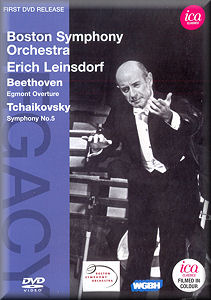 |
 |
|


alternatively
MDT
AmazonUK
AmazonUS
|
Ludwig van BEETHOVEN (1770-1827)
Egmont Overture op.84 [08:50]*
Pyotr Ilyich TCHAIKOVSKY (1840-1893)
Symphony no.5 in E minor op.64 [43:01]**
Wolfgang Amadeus MOZART (1756-1791)
Minuet I from “Posthorn” Serenade K.320 [4:21]***
 Boston Symphony Orchestra/Erich Leinsdorf
Boston Symphony Orchestra/Erich Leinsdorf
rec. 15 April 1969*,**, 15 January 1963***, Symphony Hall, Boston*,**,
Sanders Theatre, Harvard University***
Picture: 4:3, Colour/B&W; Sound: Enhanced mono; Region: 0 (worldwide)
 ICA CLASSICS ICAD 5059
ICA CLASSICS ICAD 5059  [57:00]
[57:00]
|
|
|
The previous Leinsdorf offering in this series had a very good-to-fine
Schubert 9, an even finer Schumann 4 and a wonderful Wagner
“Good Friday Music”. However much you enjoyed it, I should think
that only those present in the Boston Symphony Hall on 15 April
1969 could be fully prepared for the impact of the present resuscitation.
The first pleasant surprise that the material is in colour,
even if definition is not up to modern standards. The second
is that Leinsdorf, who was usually seen – before and after 1969
– without a baton and said in a late interview that he felt
freer to mould the music expressively with just his hands –
marches on with a longish baton and seems accustomed to wielding
it. Richard Dyer, whose eye-witness notes continue to be such
a valuable feature of this series, makes no mention of this.
It would be interesting to know more about Leinsdorf’s use and
non-use of the baton.
But all this pales before the fact that this sometimes austere
and pedantic conductor is on truly inspired and inspiring form,
conducting with total involvement. This doesn’t mean that it’s
all fast and loud: the Beethoven goes at a good but not excessive
pace and there is plenty of expressive weight to the introduction.
The wind phrases in the allegro are beautifully turned and the
coda truly blazes.
Leinsdorf’s Beethoven is a known factor. If it wasn’t always
this good, I suppose it doesn’t need a lot of imagination to
see that, on the right day, it could be. But his Tchaikovsky?
Leinsdorf only recorded one Tchaikovsky Symphony commercially,
the Sixth with the Los Angeles Philharmonic some years before
his Boston appointment. I’ve never heard this, nor have I ever
seen it spoken of with bated breath. Whereas the internet grapevine
has been shouting excitedly about this Fifth ever since somebody
posted an incomplete sound-only version, as Richard Dyer relates.
I can well understand those internet commentators who say they’ll
never listen to their other discs of the work now this is available,
or one who actually heard it at the time and has been unable
to find a performance to match it – not even Mravinsky – ever
since.
On the face of it, Leinsdorf doesn’t “do” anything particular
with the music. The introduction is brooding but also purposeful
– he notes that it is “andante” not “adagio” and one senses
a great latent power behind waiting to be unleashed. His “Allegro
con anima” does not sidle in slowly, gaining speed later, he
sets an up-front tempo straight away. It will sound very fast
to some listeners. But this is his tempo, so the first
crescendo is not accompanied by an accelerando and the hammering
passages go at about the “normal” speed. Nor does he deviate
from this tempo, except where Tchaikovsky actually requests
a slower pace for the second subject. Leinsdorf plays this with
great tenderness and free rubato, even risking some less precise
ensemble. On paper, this might sound like one of Leinsdorf’s
dogmatic demonstrations, and if he had subsequently taken the
performance into the studio I fear it might have turned into
just that. I must emphasize that here everything is white-hot
and convinces as a free expression of emotions.
So, too, does the slow movement. The tempo is pretty steady
but there is a sense of free-soaring passion which completely
effaces any sense of the four-square. The waltz has an elegance
which does not prevent exploitation of its darker moments while
the finale carries all before it. The coda has an air of crude
triumph presaging Mahler. Audience reaction is rightly rapturous
and even Leinsdorf manages some smiles. It looks as though the
Bostonians learnt to love Leinsdorf just as he was on his way
out.
I haven’t ventured to compare this with other favourites. Once
the initial impact has worn off I cannot believe that performance
by such as Mravinsky or Markevich, which have provided inspiration
to generations (and to me) can be wholly and eternally eclipsed.
The case still remains for a cooler, more brooding approach,
notably provided – in very primitive sound – by Landon Ronald.
At the opposite extreme, the capacity of late Celibidache to
bend your internal clock and suspend disbelief at his time-dilations
is not to be dismissed either. What I am quite sure of is that
Leinsdorf has belatedly entered the select list of the greatest
Tchaikovsky performances on record.
Back to batonless Leinsdorf in black and white for the Mozart
bonus. He puts on an incredibly autocratic face with black looks
all round. Those used to modern Mozart will gasp at the fullness
of the first attack, yet there is lilt as well as majesty, and
delicacy later on, Leinsdorf shaping the music with crisp finger-movements.
An interesting filler, perhaps. But don’t miss the Tchaikovsky
on any account.
Christopher Howell
|
|

